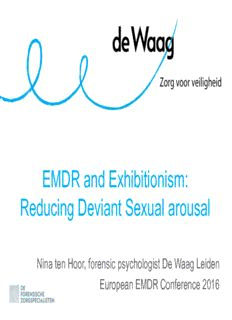
EMDR and Exhibitionism: Reducing Deviant Sexual arousal PDF
Preview EMDR and Exhibitionism: Reducing Deviant Sexual arousal
EMDR and Exhibitionism: Reducing Deviant Sexual arousal Nina ten Hoor, forensic psychologist De Waag Leiden European EMDR Conference 2016 Presentation Overview 1. Background of the Study 2. EMDR and Positive Targets 3. EMDR and Sex Offenders 4. Study Aims and design 5. Results Pilot Study 6. Erotic Transference 7. Take-Home Messages Memory Exhibitionistic Disorder (APA, 2014) • Recurrent and intense sexual arousal from the exposure of one’s genitals to an unsuspecting person, as manifested by fantasies, urges or behaviours, over a period of at least six months • The individual has acted on these sexual urges with a non-consenting person, or the sexual urges or fantasies cause clinically significant distress or impairment in social, occupational, or other important areas of functioning Background of the Study Review McNally & Fremouw on recidivism studies concerning exhibitionism (2014): 25% recidivism > 5 years 5-10% escalation to contact offending Deviant Arousal (Hildebrand, De Ruiter & Van Beek, 2001) A relatively stable pattern of sexual arousal to inappropriate or illegal stimuli, e.g. children, violence or exposing oneself to strangers, that causes significant distress or impairment in social functioning EMDR and Positive Targets When dysfunctional positive feelings are rigidly linked to problematic behaviour Alcohol and nicotine addiction (Hase, Schallmayer & l Sack, 2008) Gambling and alcohol (Miller, 2010; 2012) l Gambling and gaming (Bae, Han & Kim, 2013; Bae & l Kim, 2012) Compulsive eating (Knipe, 2009; Halvgaard, 2015) l Compulsive shopping (Popky, 2005) l Sexual addiction (Cox & Howard, 2007) l EMDR and Positive Targets EMDR and Positive Targets Miller: Feeling State Theory (FST) • Addictions are created when positive feelings become rigidly linked with specific objects or behaviour and together form a state dependent memory • The Feeling state (FS) is a total psychophysiological arousal that consists of (physical) sensations, emotions and cognitions. • FS is equally fixated as a traumatic memory, as a consequence of high level of arousal. • FS is responsible for the loss of control over the problematic behaviour. • When after successful treatment with EMDR, the FS is eliminated, the urge or compulsion will disappear.
Description: